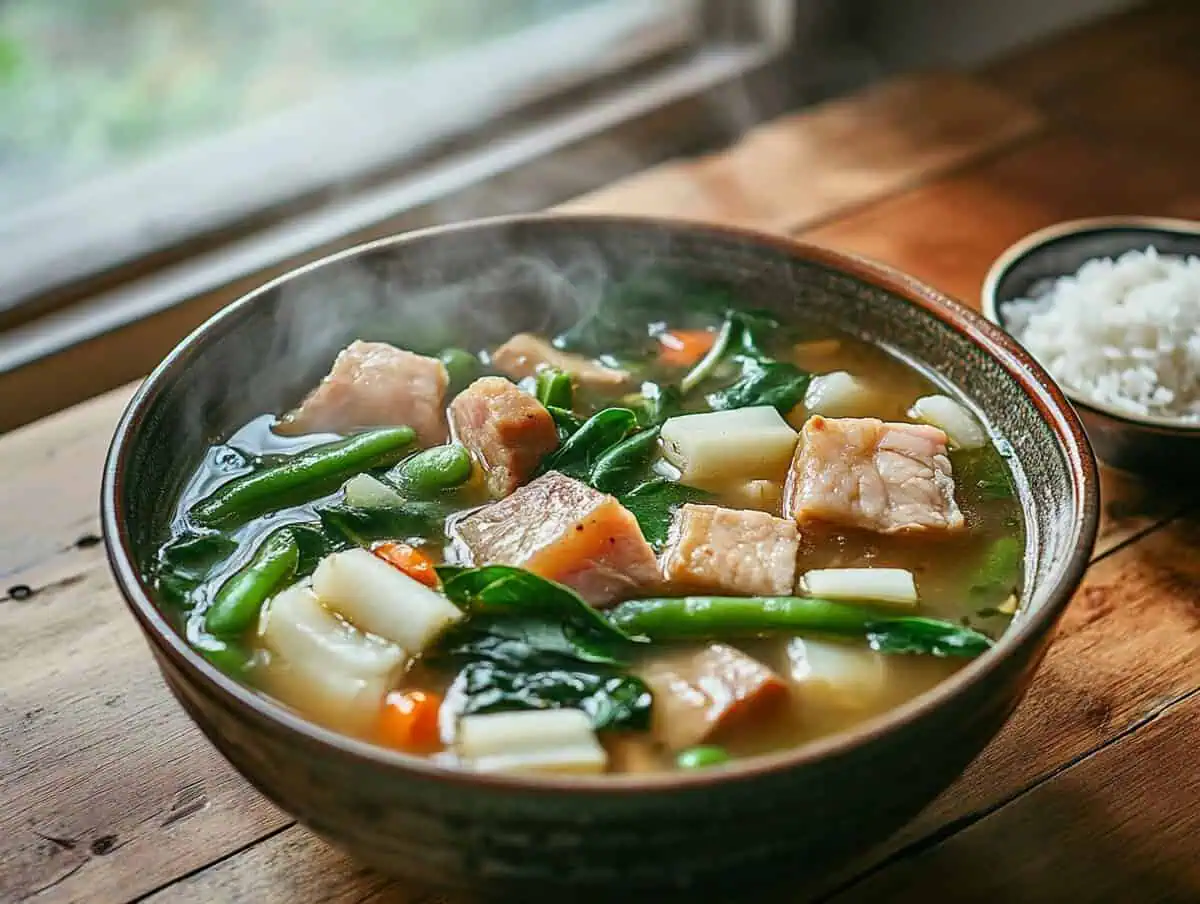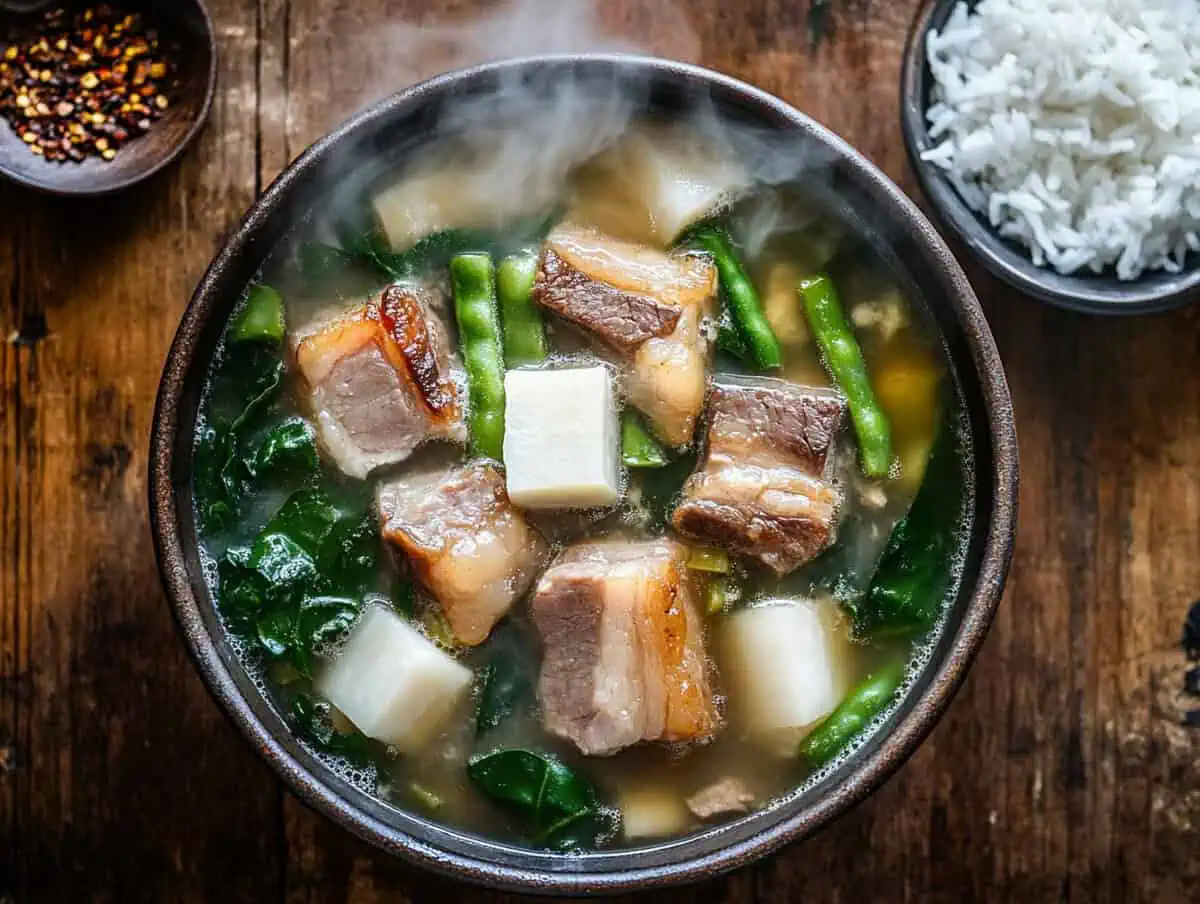When I first created this Sinigang Pork Belly recipe, I wanted to capture the perfect balance of sour, savory goodness that reminds me of Sunday family dinners back home. This Filipino soup has become my go-to comfort food for good reason.
The tender, melt-in-your-mouth pork belly chunks swim in a tangy tamarind broth alongside fresh vegetables that soak up all that amazing flavor. It's seriously the most satisfying one-pot meal that's actually quite simple to make.
Whether you're already a sinigang fan or trying it for the first time, I promise this recipe delivers that authentic taste that will have everyone asking for seconds. The best part? It tastes even better the next day!
What is Sinigang?
Sinigang is a Filipino sour soup characterized by its tangy flavor from tamarind (sampalok) or other souring agents. This iconic dish typically features meat (often pork, but sometimes beef, fish, or shrimp) and vegetables simmered in a flavorful broth.
The dish is prized for its perfect balance of sourness, umami, and fresh vegetable flavors, making it a cornerstone of Filipino cuisine and a go-to comfort food for many Filipinos worldwide.
Jump to:
Why You'll Love This Recipe
This mouthwatering Sinigang Pork Belly delivers the perfect balance of tangy, savory flavors with tender melt-in-your-mouth meat and fresh vegetables. As one of the Philippines' most beloved comfort foods, this soup will warm your soul on cold days and refresh your palette during hot weather.
The rich broth, infused with tamarind's signature sourness, creates a deliciously complex flavor profile that will keep you coming back for more. Plus, this recipe is straightforward enough for beginners while producing restaurant-quality results that will impress even the most discerning Filipino food enthusiasts.
Ingredients
I've carefully selected these ingredients to create the perfect balance of flavors and textures in this sinigang. The fatty pork belly provides richness while the vegetables add freshness and nutrition.
Daikon and taro give the soup body and absorb the tangy broth beautifully. Tomatoes and onions create a flavor base, while the sampalok mix delivers that signature sour taste that makes sinigang so special.
Each component plays an important role in this well-rounded dish that's both hearty and refreshing.

- Bunch of green beans or string beans/sitaw, ends trimmed
- 1.5 lb pork belly, sliced into ½ inch thick pieces
- 3 small tomatoes, chopped into 1-inch pieces
- 1 yellow onion, chopped into 1-inch pieces
- Spinach or kangkong (water spinach), washed with stems separated
- 1 daikon radish, sliced into ½ inch rounds
- 4 small taro/gabi
- 1 teaspoon cooking oil
- 2 liters water
- 1 packet spicy sinigang na sampalok mix
- Steamed white rice, for serving
- Patis (fish sauce), for serving
Equipment
- Large stock pot (at least 5-quart capacity)
- Small pot for boiling taro
- Sharp knife and cutting board
- Measuring spoons
- Ladle for serving
- Gloves for handling taro (optional but recommended)
- Rice cooker or pot for rice

How To Make
- Prepare the vegetables: Chop tomatoes and onion into 1-inch pieces. Trim ends of green/string beans. Thoroughly wash the spinach and separate the stems. Slice the daikon radish into ½ inch rounds.
- Prepare the meat: Cut the pork belly into ½ inch thick slices for even cooking.
- Brown the meat: In a large stock pot, heat the oil over medium heat. Add the pork belly slices and brown them lightly for about 1 minute. Add the chopped tomatoes and onions, then stir for another minute to release their flavors.
- Create the broth: Pour water into the pot. Cover and bring to a gentle simmer. Be careful not to boil vigorously as this can make the meat tough. Add the sinigang soup packet according to your taste preference.
- Prepare the taro: While the broth is simmering, boil the small taro in a separate pot over medium heat for about 20 minutes. Once done, remove from heat and allow to cool slightly. Peel off the skin (using gloves if you're sensitive to taro) and chop into halves or quarters, depending on size.
- Tenderize the meat: After simmering for 45 minutes, check if the pork is tender by piercing it with a fork. If it's not yet tender enough, continue simmering until the meat reaches your desired softness.
- Add hardy vegetables: Once the meat is tender, add the daikon radish, green beans, and prepared taro to the pot. Cook for approximately 5 minutes until the vegetables are just tender.
- Finish with leafy greens: Add the spinach last and cook for just 1-2 minutes until wilted but still bright green.
- Serve: Remove from heat and ladle into bowls. Serve hot with steamed white rice and a small saucer of patis (fish sauce) on the side for additional seasoning.

Tips from Lola's Kitchen
- For maximum flavor development: Brown the pork belly pieces thoroughly before adding liquid. This extra step creates depth of flavor in your broth.
- Perfect sourness: Start with ¾ of the sinigang mix packet, then taste and adjust according to your preference. You can always add more, but you can't remove sourness once added.
- Authentic touch: For an even more traditional flavor, use fresh tamarind instead of the packet mix. Boil about 1 cup of tamarind pulp in water, strain, and add the liquid to your soup.
- Vegetable timing: Always add vegetables in order of cooking time—root vegetables first, leafy greens last—to ensure everything is perfectly cooked.
- Best cuts: While this recipe uses pork belly for its rich flavor and tender texture, you can also use pork ribs or pork shoulder if preferred.
- Flavor enhancer: For an extra depth of flavor, add a tablespoon of shrimp paste (bagoong) to the broth.
Substitutions
- Meat options: If pork isn't your preference, try using beef short ribs, shrimp, or fish (like milkfish/bangus or snapper).
- Souring agent: If you don't have sinigang mix, use 4-5 tablespoons of tamarind paste, 4 calamansi limes, or even 2 tablespoons of lime juice mixed with 1 tablespoon of tomato paste.
- Vegetable variations: Feel free to use whatever vegetables you have on hand. Eggplant, okra, bok choy, or mustard greens work wonderfully in sinigang.
- Taro alternatives: If taro is unavailable, potatoes or sweet potatoes can be substituted, though the flavor profile will be slightly different.
- Fish sauce substitute: If you don't have patis, regular salt or soy sauce can be used to season the dish instead.
Troubleshooting
- Broth too sour: Add a teaspoon of sugar or more water to balance the flavors.
- Meat too tough: Continue simmering at a low temperature. Rushing the cooking process with high heat will result in tough meat.
- Vegetables overcooked: Remember to add vegetables in stages based on cooking time. If they're still getting too soft, add them even later in the cooking process.
- Broth too bland: Add more sinigang mix, a splash of fish sauce, or a pinch of salt.
- Oily surface: If too much fat renders from the pork belly, you can skim it off the surface with a spoon or ladle before serving.
Storage & Reheating
- Refrigeration: Store cooled leftovers in an airtight container for up to 3 days in the refrigerator.
- Freezing: Sinigang freezes well for up to 3 months. Freeze the broth and meat together, but consider freezing the vegetables separately to prevent them from becoming too soft.
- Reheating: Warm gently on the stove over medium-low heat until just simmering. Avoid vigorous boiling as it can make the meat tough and vegetables mushy.
- Flavor development: Like many soups, sinigang often tastes even better the next day as the flavors have had time to meld together.

FAQ
Can I make this in a slow cooker or Instant Pot?
Absolutely! For slow cookers, cook on low for 6-8 hours. For Instant Pot, use the "Meat/Stew" setting for 30 minutes, then quick release, add vegetables, and use "Sauté" mode to finish cooking them.
Is sinigang always spicy?
No, traditional sinigang isn't spicy. This recipe uses spicy sinigang mix for added flavor, but you can use regular (non-spicy) sinigang mix if you prefer a milder taste.
Why do you cook the taro separately?
Taro requires longer cooking than other vegetables and can disintegrate if cooked too long in the main pot. Cooking it separately ensures perfect texture.
Can I add more vegetables than listed in the recipe?
Definitely! Sinigang is very versatile. Popular additions include eggplant, okra, or long beans. Just add them at the appropriate time based on their cooking requirements.
Why is my broth cloudy?
A cloudy broth is often caused by boiling the meat too rapidly. Keep the soup at a gentle simmer for a clearer broth.
Related
Looking for other recipes like this? Try these:

Sinigang Pork Belly
Ingredients
- Bunch of green beans or string beans/sitaw ends trimmed
- 1.5 lb pork belly sliced into ½ inch thick pieces
- 3 small tomatoes chopped into 1-inch pieces
- 1 yellow onion chopped into 1-inch pieces
- Spinach or kangkong water spinach, washed with stems separated
- 1 daikon radish sliced into ½ inch rounds
- 4 small taro/gabi
- 1 teaspoon cooking oil
- 2 liters water
- 1 packet spicy sinigang na sampalok mix
- Steamed white rice for serving
- Patis fish sauce, for serving
Instructions
- Prepare the vegetables: Chop tomatoes and onion into 1-inch pieces. Trim ends of green/string beans. Thoroughly wash the spinach and separate the stems. Slice the daikon radish into ½ inch rounds.
- Prepare the meat: Cut the pork belly into ½ inch thick slices for even cooking.
- Brown the meat: In a large stock pot, heat the oil over medium heat. Add the pork belly slices and brown them lightly for about 1 minute. Add the chopped tomatoes and onions, then stir for another minute to release their flavors.
- Create the broth: Pour water into the pot. Cover and bring to a gentle simmer. Be careful not to boil vigorously as this can make the meat tough. Add the sinigang soup packet according to your taste preference.
- Prepare the taro: While the broth is simmering, boil the small taro in a separate pot over medium heat for about 20 minutes. Once done, remove from heat and allow to cool slightly. Peel off the skin (using gloves if you're sensitive to taro) and chop into halves or quarters, depending on size.
- Tenderize the meat: After simmering for 45 minutes, check if the pork is tender by piercing it with a fork. If it's not yet tender enough, continue simmering until the meat reaches your desired softness.
- Add hardy vegetables: Once the meat is tender, add the daikon radish, green beans, and prepared taro to the pot. Cook for approximately 5 minutes until the vegetables are just tender.
- Finish with leafy greens: Add the spinach last and cook for just 1-2 minutes until wilted but still bright green.
- Serve: Remove from heat and ladle into bowls. Serve hot with steamed white rice and a small saucer of patis (fish sauce) on the side for additional seasoning.
Tips from Lola's Kitchen
- For maximum flavor development: Brown the pork belly pieces thoroughly before adding liquid. This extra step creates depth of flavor in your broth.
- Perfect sourness: Start with ¾ of the sinigang mix packet, then taste and adjust according to your preference. You can always add more, but you can't remove sourness once added.
- Authentic touch: For an even more traditional flavor, use fresh tamarind instead of the packet mix. Boil about 1 cup of tamarind pulp in water, strain, and add the liquid to your soup.
- Vegetable timing: Always add vegetables in order of cooking time—root vegetables first, leafy greens last—to ensure everything is perfectly cooked.
- Best cuts: While this recipe uses pork belly for its rich flavor and tender texture, you can also use pork ribs or pork shoulder if preferred.
- Flavor enhancer: For an extra depth of flavor, add a tablespoon of shrimp paste (bagoong) to the broth.
The Story Behind Sinigang Pork Belly
Sinigang, with its distinctive sour broth and hearty ingredients, holds a special place in Filipino cuisine as one of the nation's most beloved dishes. This tangy soup has been warming Filipino homes for centuries, with roots stretching back to pre-colonial times when indigenous cooking techniques relied heavily on local ingredients and preservation methods.
Before refrigeration, ancient Filipinos discovered that souring agents like tamarind (sampalok) could preserve food while adding incredible flavor. This practical necessity evolved into one of the Philippines' signature cooking styles – the art of creating sourness in dishes. Sinigang perfectly exemplifies this culinary tradition, with its tamarind-based broth forming the backbone of this iconic recipe.
The dish varies greatly across the Philippines' 7,641 islands, reflecting the country's diverse regional ingredients and cultural influences. In northern Luzon, you might find it made with guava instead of tamarind, while southern regions might incorporate additional local souring agents like kamias (bilimbi) or batuan. In coastal areas, fish and seafood versions dominate, while inland communities prefer pork or beef variations like our pork belly sinigang.
What makes sinigang truly special is how it embodies the Filipino value of "salu-salo" or gathering around food. The large pot of soup placed at the center of the table encourages sharing and conversation. The dish is designed to bring people together, with each household developing its own slightly different recipe passed down through generations.
Modern sinigang, especially in busy urban households, often incorporates convenience items like tamarind soup mix packets (which I use in this recipe). This innovation has made this traditional dish more accessible to contemporary cooks while maintaining its essential flavor profile. Despite this modern shortcut, the soul of sinigang remains unchanged – a perfect balance of sour and savory that instantly transports Filipinos to childhood memories of family meals.
The pork belly version has become particularly popular because the rich, fatty meat creates a wonderful contrast with the sharp, sour broth. As the pork simmers, it infuses the soup with flavor while becoming tender enough to melt in your mouth. This harmonious balance between rich meat and bright soup exemplifies Filipino cuisine's masterful play of contrasting flavors and textures.
Whether enjoyed during rainy season as comfort food or served at family celebrations, pork belly sinigang remains a cornerstone of Filipino food identity. Its simple preparation belies a complex flavor profile that continues to win fans worldwide as Filipino cuisine gains deserved recognition on the global culinary stage.
When you prepare this recipe, you're not just making a delicious meal – you're participating in a centuries-old culinary tradition that has nourished generations of Filipino families. The distinctive sourness that first hits your palate connects you to a heritage of ingenious cooking that transformed preservation techniques into beloved comfort food.










Comments
No Comments